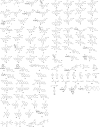The Genus Eriosema (Fabaceae): From the Ethnopharmacology to an Evidence-Based Phytotherapeutic Perspective?
- PMID: 34025412
- PMCID: PMC8138667
- DOI: 10.3389/fphar.2021.641225
The Genus Eriosema (Fabaceae): From the Ethnopharmacology to an Evidence-Based Phytotherapeutic Perspective?
Abstract
The genus Eriosema (Fabaceae) includes approximately 150 species widely distributed across tropical and subtropical regions of the world (Africa, Neotropics, Asia and Australia). Throughout these regions, several species are used since centuries in different traditional medicinal systems, while others are used as food or food supplement. The present review attempts to critically summarize current information concerning the uses, phytochemistry and pharmacology of the Eriosema genus and to evaluate the therapeutic potential. The information published in English and French (up to September 2020) on ethnopharmacology or traditional uses, chemistry, pharmacology and toxicology of Eriosema genus was collected from electronic databases [SciFinder, PubMed, Google, Google Scholar, Scopus, Web of Science, Prelude Medicinal Plants-http://www.ethnopharmacologia.org/recherche-dans-prelude/?plant, The Plant List (http://www.theplantlist.org/), POWO (http://powo.science.kew.org/) and IUCN Red List Categories (https://www.iucnredlist.org/)], conference proceedings, books, M.Sc. and Ph.D. dissertations. The information retrieved on the ethnomedicinal indications of Eriosema genus allowed to list 25 species (∼16.6% of the genus). The majority of uses is recorded from Africa. Phytochemical analyses of 8 species led to the identification and/or isolation of 107 compounds, with flavonoids (69.2%), chromones (7.5%) and benzoic acid derivatives (3.7%) as the main chemical classes. Pharmacological investigations with crude extracts and isolated compounds showed a broad range of activities including aphrodisiac, estrogenic, anti-osteoporosis, hypolipidemic, anti-diabetic, anti-diarrheal, anti-microbial, anti-oxidant, anthelmintic, anti-cancer, and acetylcholinesterase inhibitory activities. Despite the low number of Eriosema species tested, there is convincing evidence in vitro and in vivo studies validating some traditional and ethnobotanical uses. However, the utility of several of the described uses has not yet been confirmed in pharmacological studies. Reviewed data could serve as a reference tool and preliminary information for advanced research on Eriosema species.
Keywords: Eriosema; Fabaceae; ethnopharmacology; pharmacological activities; phytochemistry; toxicology.
Copyright © 2021 Ateba, Njamen and Krenn.
Conflict of interest statement
The authors declare that the research was conducted in the absence of any commercial or financial relationships that could be construed as a potential conflict of interest.
Figures




Similar articles
-
Phytochemistry and pharmacology of the genus Drypetes: A review.J Ethnopharmacol. 2016 Aug 22;190:328-53. doi: 10.1016/j.jep.2016.06.060. Epub 2016 Jun 25. J Ethnopharmacol. 2016. PMID: 27353868 Review.
-
Traditional uses, phytochemistry, pharmacology and toxicology of the genus Cimicifuga: A review.J Ethnopharmacol. 2017 Sep 14;209:264-282. doi: 10.1016/j.jep.2017.07.040. Epub 2017 Aug 4. J Ethnopharmacol. 2017. PMID: 28826891 Review.
-
Ethnopharmacological uses, phytochemistry, biological activities, and therapeutic applications of Clinacanthus nutans (Burm. f.) Lindau: A comprehensive review.J Ethnopharmacol. 2017 Jul 12;206:245-266. doi: 10.1016/j.jep.2017.05.007. Epub 2017 May 8. J Ethnopharmacol. 2017. PMID: 28495603 Review.
-
A review of the ethnobotany, contemporary uses, chemistry and pharmacology of the genus Thesium (Santalaceae).J Ethnopharmacol. 2020 Jun 28;256:112745. doi: 10.1016/j.jep.2020.112745. Epub 2020 Mar 15. J Ethnopharmacol. 2020. PMID: 32188571 Review.
-
Medicinal plants of the genus Anthocleista--A review of their ethnobotany, phytochemistry and pharmacology.J Ethnopharmacol. 2015 Dec 4;175:648-67. doi: 10.1016/j.jep.2015.09.032. Epub 2015 Nov 11. J Ethnopharmacol. 2015. PMID: 26432351 Review.
Cited by
-
Bioactivity of Wild and Cultivated Legumes: Phytochemical Content and Antioxidant Properties.Antioxidants (Basel). 2023 Apr 1;12(4):852. doi: 10.3390/antiox12040852. Antioxidants (Basel). 2023. PMID: 37107225 Free PMC article.
-
South African Medicinal Plants Traditionally Used for Wound Treatment: An Ethnobotanical Systematic Review.Plants (Basel). 2025 Mar 5;14(5):818. doi: 10.3390/plants14050818. Plants (Basel). 2025. PMID: 40094805 Free PMC article. Review.
-
Exploring the Phytochemicals and Anti-Cancer Potential of the Members of Fabaceae Family: A Comprehensive Review.Molecules. 2022 Jun 16;27(12):3863. doi: 10.3390/molecules27123863. Molecules. 2022. PMID: 35744986 Free PMC article. Review.
-
Ethnomedical Knowledge of Plants Used in Nonconventional Medicine for Wound Healing in Lubumbashi, Haut-Katanga Province, DR Congo.ScientificWorldJournal. 2024 Aug 12;2024:4049263. doi: 10.1155/2024/4049263. eCollection 2024. ScientificWorldJournal. 2024. PMID: 39376217 Free PMC article.
-
The Antioxidant and Anti-Inflammatory Activities of the Methanolic Extract, Fractions, and Isolated Compounds from Eriosema montanum Baker f. (Fabaceae).Molecules. 2024 Dec 13;29(24):5885. doi: 10.3390/molecules29245885. Molecules. 2024. PMID: 39769974 Free PMC article.
References
-
- Abdelsamie A. S., Salah M., Siebenbürger L., Merabet A., Scheuer C., Frotscher M., et al. (2019). Design, synthesis, and biological characterization of orally active 17β-hydroxysteroid dehydrogenase type 2 inhibitors targeting the prevention of osteoporosis. J. Med. Chem. 62 (15), 7289–7301. 10.1021/acs.jmedchem.9b00932 - DOI - PubMed
-
- Adjanohoun E., Ahyi M. R. A., Ake Assi L., Dramane K., Elewude J. A., Fadoju S. O., et al. (1991). Contribution to ethnobotanical and floristic studies in Western Nigeria. Nigeria: CSTR-OUA, 420.
-
- Adjanohoun E. J., Adjakidje V., Ahyi M. R. A., Ake Assi L., Akoegninou A., d'Almeida J., et al. (1989). Contribution aux études ethnobotaniques et floristiques en République populaire du Bénin. Agence de coopération culturelle et technique, (A.C.C.T.). Paris: Lagos, 895.
-
- Adjanohoun E. J., Adjakidje V., Ahyi M. R. A., Akpagana K., Chibon P., El-Hadji A., et al. (1986). Contribution aux études ethnobotaniques et floristiques au Togo. Agence de coopération culturelle et technique, (A.C.C.T.). Paris: Lagos, 671.
-
- Adjanohoun E. J. (1993). Contribution to ethnobotanical and floristic studies in Uganda. O.U.A./C.S.T.R. Paris: Lagos.
Publication types
LinkOut - more resources
Full Text Sources
Other Literature Sources
Molecular Biology Databases

